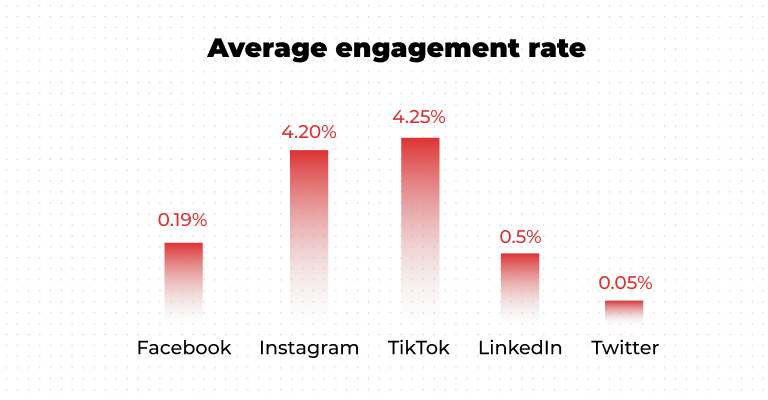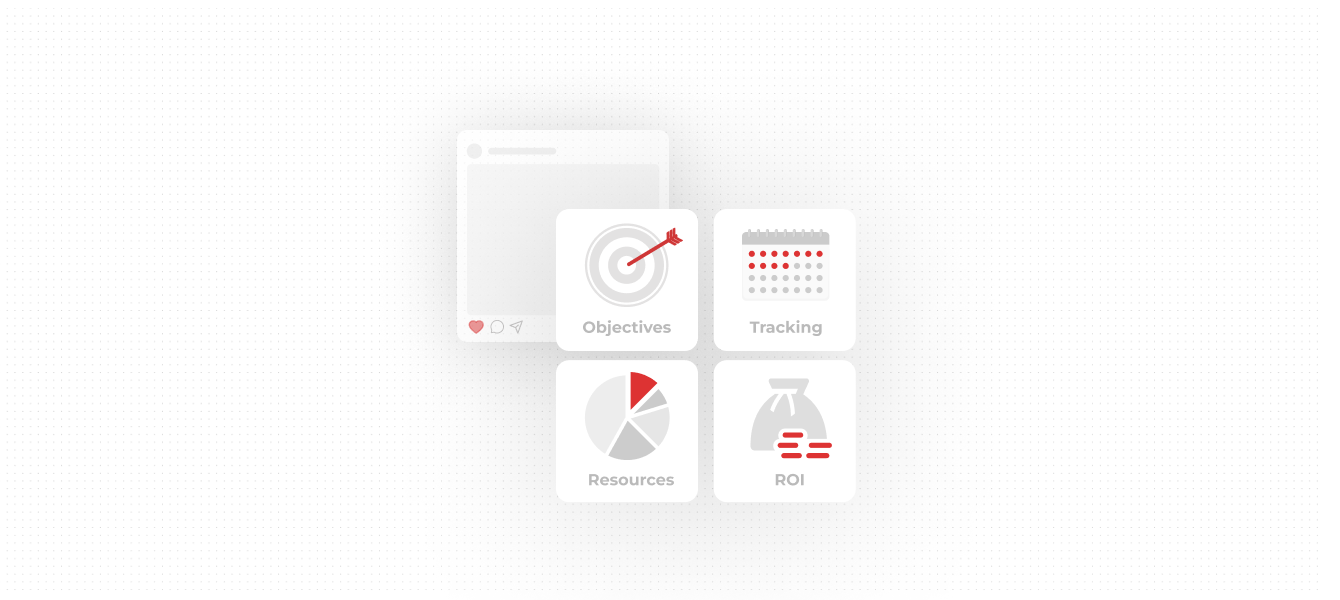Social media has become an indispensable tool for businesses, brands, and individuals alike to connect, engage, and expand their brand awareness in the digital landscape. With billions of active users across various platforms, it presents an incredible opportunity for businesses to promote their products, services, and messages to a vast and diverse audience.
According to Forbes, 77% of businesses reach customers through social media. More so, almost half of the small businesses (44%) use it to build up brand awareness, while 41% consider social media as the main revenue driver. On the consumer side, a staggering 90% of users follow at least one brand on social media.
However, to truly succeed in the social media race, and to be able to scale up your business, it is crucial to define a clear measurement framework.
The significance of measurement criteria
As we stated already, in a very competitive market with new players entering and competing every day, setting clear objectives and having well-defined measurement criteria became essential for achieving results. Might seem obvious, but many businesses fail to cover this step. Without the proper metrics & benchmarks in place, it becomes increasingly challenging to evaluate the effectiveness of a campaign and make informed decisions for future marketing strategies, including budget spent, timeline, seasonality and so on.
a. Defining Objectives
A healthy measurement framework helps a great deal in crystallizing overall campaign objectives. Whether it’s increasing brand awareness, driving website traffic, generating leads, or boosting sales, having specific, measurable, achievable, relevant, and time-bound (SMART) goals ensures a much more focused approach.
Amongst the benefits of having clearly defined objectives, we underline some of the most important ones:
Focus
Clear objectives help in directing the efforts of a campaign or project towards a specific outcome, preventing wasted resources on activities that don’t align with the goal.
Alignment
Well-defined objectives ensure that everyone involved understands the purpose and target of the campaign, creating alignment and coordination among team members.
Measurement
Clear objectives provide a basis for measuring success. They allow you to track progress, assess the effectiveness of your strategies, and make data-driven adjustments if needed.
Motivation
Having specific goals gives the team a clear sense of purpose and accomplishment when the objectives are met. It can boost motivation and drive to achieve the desired results.
On the other hand, not having those clear objectives has it’s certain disadvantages:
- Lack of Focus: Without a clear objective, your social media efforts will most probably lack direction & purpose. You may end up posting content that can dilute your brand message and confuse your audience.
- Reduced ROI: Without clear goals, it’s hard to determine the return on investment (ROI) for your social media efforts. You won’t be able to assess whether your campaigns are generating the desired outcomes or if adjustments are needed to improve ROI.
- Difficulty in Tracking Success: Measuring the success of your campaigns becomes challenging if you don’t have specific objectives to track. It’s crucial to know what you’re trying to achieve so you can measure progress and make informed decisions.
b. Tracking Progress
At the same time, effective measurement criteria enable us to monitor the progress of social media campaigns, without needing to have it done in order to draw conclusions on the relative success it had.
By regularly evaluating key metrics, you can identify what works and what doesn’t, thus making it easier to refine your strategies & tactics. Usually, the social media strategy is made one year ahead, so it should be reevaluated every 3 months in order to optimize it.
c. Resource Allocation
We know that Social media campaigns require time, effort, and financial investment. Proper measurement criteria helps in allocating resources wisely, ensuring that you focus on channels & activities that provide the best results while also being able to test out new approaches.
Also, it is important to narrow down your audience based on the brand’s objectives and specifics. By accurately defining your target audience, you can create content and messaging that resonates with them. This leads to more meaningful and effective communication, increasing the likelihood of engagement, conversions, and customer satisfaction.
When you know exactly who your audience is, you can allocate your resources (time, budget, and effort) much more efficiently. You can focus on the platforms and strategies that matter most to your audience, rather than spreading resources thin across less relevant areas.
- Understanding ROI
Return on Investment (ROI) is crucial in determining the success of any marketing initiative. By defining measurement criteria, businesses can gauge the ROI of their social media campaigns and understand their impact on overall business goals.
Key Measurement Criteria for Social Media Success
The key measurement criteria for social media success can vary depending on the goals and objectives of a particular business or individual. Since it is mainly a content focused channel the characteristics of the content we generate plays a significant role in social media strategy.
Published content must have a purpose and be able to create a connection, whether it’s to inform, engage, entertain etc.
More so, content must be created based on the overarching goals of the business and the monthly objectives.
Regardless of the specifics, we lay out some of the most common metrics and criteria to consider when evaluating the success of social media efforts:
-
Engagement
This measures the level of interaction and involvement of users across social media platforms, with your original content. Key engagement metrics include likes, comments, shares, saves, reactions, mentions and retweets. An increased engagement rate indicates a thriving online community centered around your company, signifying that your audience appreciates and enjoys your digital content while also establishing a strong bond with your business.
On the other hand, a decreased engagement rate suggests the necessity for reevaluating your social media content and adopting a new marketing strategy. The lower your engagement rates are, the less likely your content will be prioritized and displayed to users on social media platforms, as this aligns with the algorithms used by channels like Instagram.
According to a recent study by Social Insider, the average engagement rates vary across different social media channels, and they differ over time. Here is how you can measure your engagement rate on each platform:

-
Reach
Reach serves as an effective gauge for brand awareness among individuals, distinct from metrics like followers or impressions. It provides a more precise tally of the individuals who have been influenced by your brand, aiding in estimating your audience size. Monitoring reach on social media allows you to promptly assess the efficiency of your campaigns and enact required modifications before any potential repercussions.
The measurement of reach can be intricate due to its focus on unique users who encountered your content. To calculate the average reach rate, you can divide a post’s total reach by your overall follower count and then multiply the outcome by 100.
A study conducted by Social Insider shows that back in 2021, Instagram registered an average reach rate of 13.90%, while Facebook’s average reach rate only went up to 6.53%. And in 2023, the average reach rate for both platforms has decreased dramatically – to 9.34% on Instagram and only 4.32% on Facebook.
-
Impressions
This represents the total number of times your content has been displayed, regardless of whether it was clicked or not. It gives an idea of how often your content is being shown to users.
Impressions are calculated by tracking the total number of times your content was displayed across a platform, like in the user’s feed or search results. Just like the reach, you can calculate overall impressions for all your content, or see how many you got on a single post.
-
Click-through Rate (CTR)
This measures the percentage of users who clicked on a link or call-to-action in your social media posts. It is a good indicator of how compelling your content and calls-to-action are.
Numerous factors influence the levels of your Click-Through Rates (CTRs), and among them, URLs play a significant role. It is essential to incorporate relevant keywords into your URLs, whether they are short-tail or long-tail. Research indicates that URLs containing keywords experience a 45% increase in click-through rates compared to those lacking them.
Furthermore, leveraging long-tail searches can also contribute to higher click-through rates, thereby recommending against focusing solely on specific keywords.
Although meta descriptions may not have a direct impact on the algorithm, they do influence your CTR.
According to a recent analysis Facebook has the highest CTR – 3.86% on average, followed by LinkedIn. While Facebook’s CTR is located at an average of 4.02%, LinkedIn also delivers pretty good results in terms of click-through rate, with an average of 3.55%.
-
Conversion Rate
Conversion rate measures how often your social content starts the process to a conversion event like a subscription, download, or sale. This is one of the most important social media marketing metrics because it shows the value of your social content as a means of feeding your funnel.
To sum things up
Measurement criteria is the backbone of successful social media campaigns. By clearly defining objectives and tracking relevant metrics, businesses and marketers alike can make data-driven decisions, optimize their strategies, and ultimately achieve their desired outcomes.
The key is to select measurement criteria that align with your campaign’s goals and adapt them as needed to ensure continuous improvement and growth in the dynamic world of social media marketing.
Understanding what works and what doesn’t is also a must for achieving social media success, and measurement criteria pave the way for that understanding.
However, there are many other aspects you need to consider when choosing social media as your marketing channel. But on that, in some other material.
If you need help in managing your social media brand presence and campaigns, get in touch at hello@datarevolt.agency

